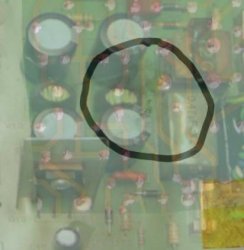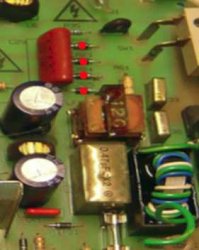Some update on my plus.
So, it's working the way I can turn it on. Actually no special lessons on that. As His Majesty MacTech68 said before - some of the tracks were in a pretty bad condition due to humidity and so. What was done:
1) All the electronic parts on video/analog boards checked - test passed and believe or not all seem to be fine
2) Minor yoke adjustment - didn't realy have much of the impact
3) Minor tracks cleanup (analog board) - only some of them got bad and those were cleaned, optically there is not all of that much of a difference, now all tracks pass the test with one restriction - it doesn't really mean that they may not go bad again. For such all the board would have to be totally reworked, which (in expert's opinion) did not make much sense.
The plus is back home and there is still much to do. I'll basically tell all of the story maybe y'all would have some suggestions. Guess would be better that way than just do sth bad to it

The story. As some may remember initially I observed the shaky screen on startup. And - didn't mention much on that back then - the FDD problem. It would accept disks and eject right away all of them including the very right ones (800K with right system - tested to work fine in othere macs). Let's call it drive "A". I got me another drive, put in and more or less then my last problems accured. When plus returned home - with drive "B" it turned out that it was really "As-is" one and bad, i.e. wouldn't work and make awfull noise (possibly stuck or some part burnt) but the repair didn't cover it and I didn't dig into that either. Drive noise is a noise but... the shaking went away (!?).
Now it gets complicated. I got me a perfectly working external 800k drive. Let's call it "C" - now the combinations:
1) Pulled out drive "C" out of the case and put into plus - keps ejecting exactly as with drive "A" as described above; shaky screen on startup came back
2) Option one + external case with drive "A" in external case - sympthomas as in 1) plus startup from external drive gives - smiley mac for a few seconds and... disk is ejected (?!)
3) Drive "C" in external case, drive "A" in plus - disk with system in external - boots right but has the shaky screen for about 5 minutes; internal ejects disks; the same config but with scsi ribbon unplugged from the internal fdd... the same results (didn't check unplugging from the board yet)
More combinations to go. What's interesting - boots fine on external but with shaky picture. And then no shaky screen with broken "B" drive in plus (making awful noise). Seems like might be something related to board connection - fdd/motherboard or drives themseves. I replaced the ribbon itself - no impact.
This much for now

I'll post pictures of warmed up working plus with system 1.1 on it (off the external drive) later.
Regards
Ok, I tried another combination which I suspected to work fine (based on previous ones):
- Drive "C" in original case as external drive and drive "A" (the original one and faulty) still in a bay but unplugged from the motherboard... And plus boots and there is no shaky screen effect. At any stage, i.e. in the very beginning before the external drive picks up (the grey screen), during boot and over normal work course.
Please correct me if I'm thinking right:
1) the fine working "C" drive didn't work as internal (kept ejecting as original)
2) with internal drive unplugged from the motherboard (which basically means any drive) and the fine working "C" drive in a case as external - everything works fine (boots and no shaky screen)
3) two different ribbons tested with no difference
...
this might be sth related to the FDD drive socket at the motherboard or eventually something further related to FDD at the motherboard controlling the internal drive in particular?
Regards













